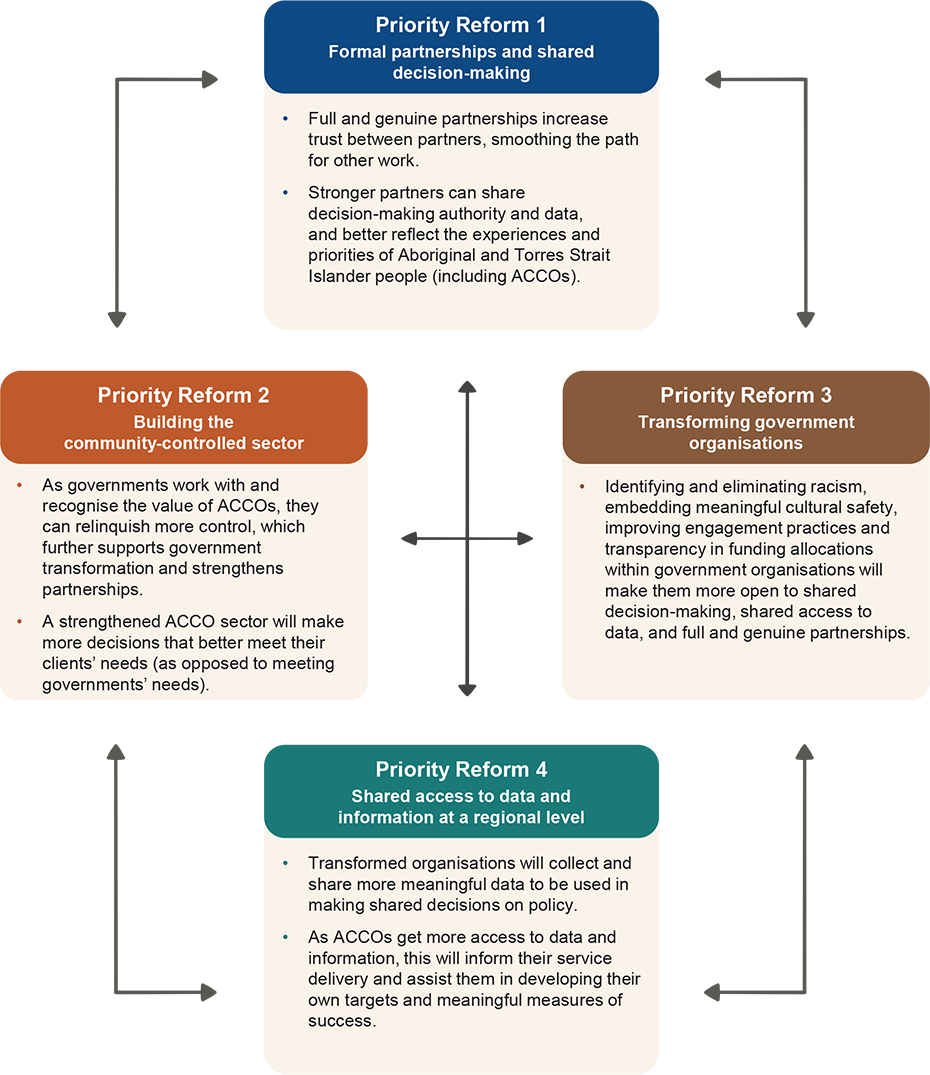 There are several dependencies and enablers that are critical to the success of the framework. These dependencies are addressed through multiple national and NSW policies and strategies that aim to improve Aboriginal health.
There are several dependencies and enablers that are critical to the success of the framework. These dependencies are addressed through multiple national and NSW policies and strategies that aim to improve Aboriginal health.
NSW and National policies and strategies
The vision of the
NSW Aboriginal Health Plan is ‘Sharing power in system reform to achieve the highest levels of health and wellbeing for Aboriginal people’. The elevation of the voices of Aboriginal people across all levels of decision making in NSW Health is critical to the implementation of the NSW Aboriginal Health Plan. The framework is a tool to enable the vision of the plan to be implemented in NSW Health through embedding the principles of self-determination, shared decision making and accountability for Aboriginal health3.
Future Health: Guiding the next decade of health care in NSW 2022-2032 is a roadmap for NSW Health for how it delivers services over the coming decade. The framework supports the implementation of some of Future Health’s key objectives:
1.1: Partner with patients and communities to make decisions about their own care.
1.4: Partner with consumers in co-design and implementation of models of care.
2.3: Connect with partners to deliver integrated care services.
3.5: Close the Gap by prioritising care and programs for Aboriginal people.
6.1: Drive value based healthcare that prioritises outcomes and collaboration.
6.4: Align our governance and leaders to support the system and deliver the outcomes of Future Health4.
The
NSW Regional Health Strategic Plan 2022–2032 guides NSW Health’s strategic focus in regional, rural and remote communities for the next 10 years5. Its vision is for a sustainable, equitable and integrated health system that delivers outcomes for patients and communities in regional, rural and remote NSW.
The
Aboriginal Workforce Composition Policy Directive provides direction to LHDs, SHNs and other NSW Health organisations on growing and developing their Aboriginal workforces. Although NSW Health Aboriginal Workforce is outside the scope of this framework, it is a critical dependency and enabler to the framework’s success6.
The framework aims to support the implementation of the Priority Reform Areas from the
National Agreement on Closing the Gap (CTG) and respond to the concerns raised in the 2024 Productivity Commission report7. The framework is an action of the
2022-2024 NSW Implementation Plan for Closing the Gap.
The National Agreement on Closing the Gap:
- was signed in 2020 by all Australian jurisdictions and the Coalition of Aboriginal Peak Organisations, as the representative of Aboriginal people,
- governs the ways in which Australian Governments and Aboriginal people work together to overcome the inequalities experienced by Aboriginal people because of colonisation and subsequent institutional racism, intergenerational trauma, and social exclusion,
- is underpinned by the recognition that new ways of working were required to achieve meaningful change and that better outcomes are achieved when Aboriginal people have a genuine say in the design and delivery of services that affect them.
Interconnected priority reforms

Figure 1: How the Priority Reforms are closely interconnected, taken from page 68 of the Draft report –Review of the National Agreement on Closing the Gap (pc.gov.au). Acknowledging this diagram excludes the NSW-specific Priority Reform 5.
Text alternative
NSW Health corporate and clinical governance structures
The framework has been developed within the context of NSW Health’s existing corporate and clinical governance structures. The framework aims to strengthen these existing governance structures through embedding and amplifying Aboriginal voices, shared decision making and self-determination.
The
NSW Health Performance Framework provides a clear and transparent outline of how LHDs, SHNs and NSW Health support services’ performance is assessed and how responses to performance concerns are structured and managed. Service Agreements are a central component of the Performance framework. By setting out service and performance expectations and funding, they support the evolution of decision making, responsibility and accountability for safe, high quality, patient centred care to LHDs, other health services and support organisations. The framework includes objectives to ensure that LHD health plans and programs are developed in partnership with Aboriginal people and reflect Aboriginal health priorities, as identified by Aboriginal services and communities8.
The
NSW Health Corporate Governance and Accountability Compendium outlines the governance requirements for NSW Health organisations, as well as setting out their roles, responsibilities and relationships. The Compendium outlines how the NSW Health system will be held accountable for Aboriginal health. The Compendium sets out the key elements of a robust governance framework for organisations within the Health portfolio and are underpinned by the seven governance standards:
- Establish robust governance and oversight frameworks.
- Ensure clinical responsibilities are clearly allocated and understood.
- Set the strategic direction for the organisation and its services.
- Monitor financial and service delivery performance.
- Maintain high standards of professional and ethical conduct.
- Involve stakeholders in decisions that affect them.
- Establish sound audit and risk management practices9.
The
NSW Health Clinical Governance in NSW Policy Directive (PD2024_010) outlines key requirements for effective clinical governance to ensure the best clinical outcomes possible10. NSW public health services are accredited against the
National Safety and Quality Health Service Standards to provide a quality assurance mechanism that assesses whether appropriate systems are in place to ensure that expected standards of safety and quality are met. Within the NSQHS Standards, six actions have been identified to specifically meet the needs of Aboriginal people. These are:
- The health service organisation works in partnership with Aboriginal communities to meet their healthcare needs
- The governing body ensures that the organisation’s safety and quality priorities address the specific health needs of Aboriginal people
- The health service organisation implements and monitors strategies to meet the organisation’s safety and quality priorities for Aboriginal people
- The health service organisation has strategies to improve the cultural awareness and cultural
- competency of the workforce to meet the needs of its Aboriginal patients
- The health service organisation demonstrates a welcoming environment that recognises the importance of cultural beliefs and practices of Aboriginal people
- The health service organisation has processes to routinely ask patients if they identify as being of Aboriginal origin, and to record this information in administrative and clinical information systems11.